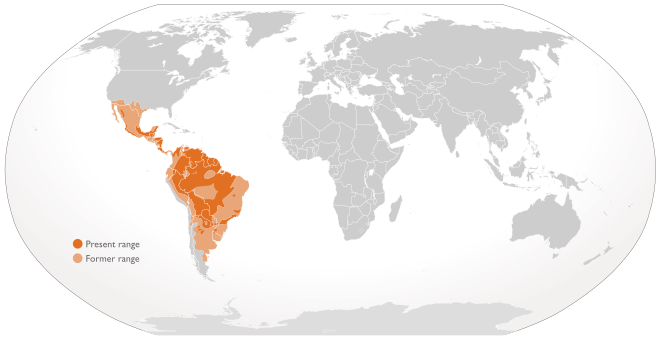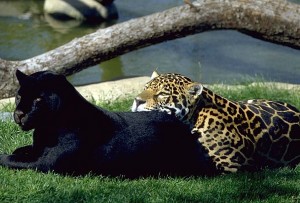Jaguars (Panthera onca) from from near the tip of South America through what is now the Southwestern United States. It is one of the largest cats in the world. The larger males can grow to be over 300 pounds with bodies up to 6 feet and tails up to 3 feet in length. In build, they are stocky and low to the ground with big heads and exceptionally strong jaws, used for biting through its prey’s skull in order to deliver the fatal blow. This pure strength and stealthy, silent hunting style make it the apex predator of its environment. Jaguars are at home in trees, on the jungle floor, and even in water, making for an expansive dominion. The coloration of jaguars is one of their more interesting and unique characteristics. Jaguars can be tawny, reddish to chocolate brown, or completely black.
Although the genetics behind the coat colors of jaguars are not completely clear, there is a definite continuum of visible coloration from a tawny background to shades of cinnamon and dark brown to inky black. The spots, known as rosettes for their characteristic loose, open series of spots and crescents, are always black. What is known is that in jaguars, versus almost all other species, the darker coats are genetically dominant rather than recessive.
“Melanism” –greater pigment– is usually the rarer trait, but not here. It is hypothesized that black-on-black coats provide the best camouflage in the deep rainforest shadows and during the night when jaguars hunt, making it an evolutionary plus (the darker individuals more likely to survive to mate). Still today there are more documented black jaguars in what remains of Brazil’s rainforest, supporting this theory. If dark is dominant, then an interesting situation occurs in which dark mothers may be seen more often with all different colors of cubs than tawny mothers. Both dark parents or one dark parent and one light will yield mostly dark and a few light cubs, while two light parents can only create tawny cubs. Overall, there will be more variation if a parent is dark, which might seem as though the melanistic jaguar had greater powers to generate the full range of coloration. This could easily be interpreted as the darker ones being dominant in a conceptual sense, as well as simply more plentiful (especially in the past when the rainforest was vast). A natural hierarchy of coat coloration goes hand in hand with the genetic scheme.
In art, these qualities of jaguar genetics have some important implications. All three of the coat colors are faithfully represented in works of art, showing that ancient peoples were well aware of the distinctions. Furthermore, in ceramics making black-on-black images is a greater challenge technically than painting polychromes directly. Blackware involves snuffing out the fire but keeping it hot enough to carbonize the surfaces, any contaminating air ruining the effect. Black pigmentation requires special effort and skill, placing it parallel at the top of the artistic hierarchy.

